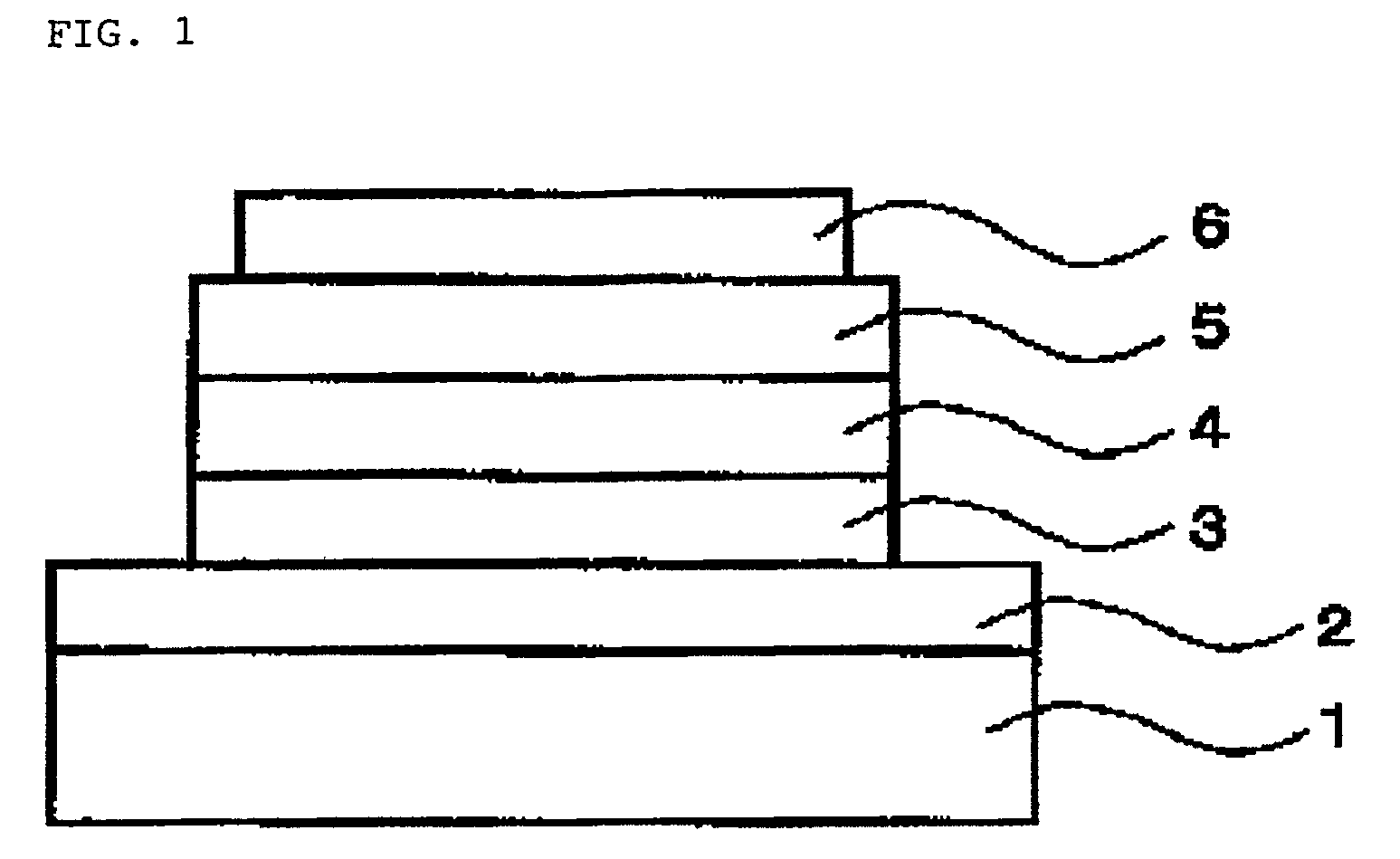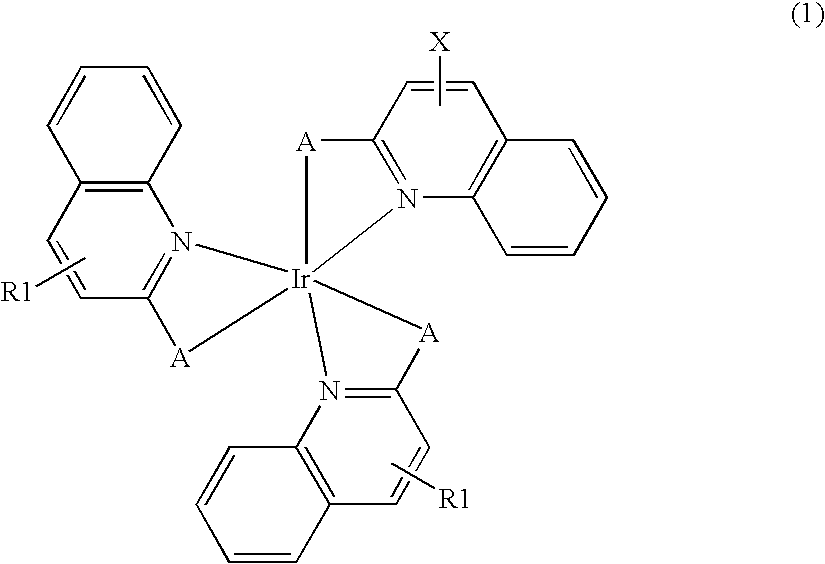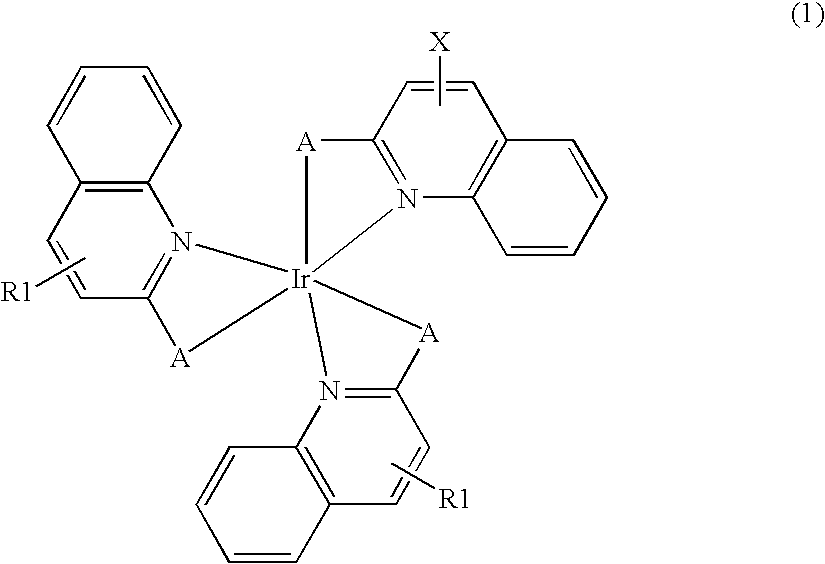Light emitting polymer material, organic electroluminescence device and display device comprising light emitting polymer material
a technology of light-emitting polymer and organic electroluminescence, which is applied in the direction of discharge tube luminescnet screens, natural mineral layered products, etc., can solve the problems of low luminance brightness of organic materials capable of highly efficient red light with a high luminance brightness, and film thickness is liable to become non-uniform, etc., to achieve high luminance brightness, simplified manufacturing steps of organic el devices, and high luminous efficiency
- Summary
- Abstract
- Description
- Claims
- Application Information
AI Technical Summary
Benefits of technology
Problems solved by technology
Method used
Image
Examples
synthesis example 1
Synthesis of bis(2-(2-quinolyl)phenyl) (2-(6-vinyl-2-quinolyl)phenyl)iridium (Compound (I))
[0117]
[0118]To a mixture of 0.68 g (1.9 mmoles) of iridium trichloride trihydrate and 0.80 g (3.9 mmoles) of 2-phenylquinoline, 15 mL of 2-ethoxyethanol and 5 mL of water were added, and the mixture was refluxed under heating for 12 hours. A formed precipitate was washed with methanol and dried in vacuo. To a mixture of 0.30 g of the resulting solid and 0.11 g (0.48 mmoles) of 2-phenyl-6-vinylquinoline, 50 mL of toluene and 0.123 g (49 mmoles) of silver trifluoromethanesulfonate were added, and the mixture was refluxed under heating for 12 hours. The resulting reaction mixture was filtered by Celite, and the solvent was distilled off. The resulting solid was purified by silica gel column chromatography (eluting solution: chloroform) to obtain 0.04 g (0.05 mmoles) of Compound (I).
[0119]FAB-MS: 831 (M+). Elemental analysis: Calculated for C47H32IrN3: C, 67.93; H, 3.88; N, 5.06. Found: C, 68.32; ...
synthesis example 2
Synthesis of bis(2-(2-quinolyl)phenyl) (6-(4-vinylphenyl)-2,4-hexanedionato)iridium (Compound (II))
[0120]
[0121]To a mixture of 0.68 g (1.9 mmoles) of iridium trichloride trihydrate and 0.80 g (3.9 mmoles) of 2-phenylquinoline, 15 mL of 2-ethoxyethanol and 5 mL of water were added, and the mixture was refluxed under heating for 12 hours. A formed precipitate was washed with methanol and dried in vacuo. To a mixture of 0.30 g of the resulting solid and 0.20 g (0.92 mmoles) of 6-(4-vinylphenyl)-2,4-hexanedione, 10 mL of N,N-dimethylformamide and 0.14 g (1.0 mmole) of potassium carbonate were added, and the mixture was stirred at 100° C. for 12 hours. The resulting reaction mixture was thrown into 200 mL of water, and a formed precipitate was washed with water and dried in vacuo. The resulting solid was purified by silica gel column chromatography (eluting solution: chloroform) to obtain 0.18 g (0.22 mmoles) of Compound (II).
[0122]FAB-MS: 816 (M+). Elemental analysis: Calculated for C45...
synthesis example 3
Synthesis of bis(5-t-butyl-2-(2-quinolyl)phenyl) (5-vinyl picolinate)iridium (Compound (III))
[0123]
[0124]To a mixture of 0.68 g (1.9 mmoles) of iridium trichloride trihydrate and 1.1 g (4.2 mmoles) of 2-(4-t-butylphenyl)quinoline, 15 mL of 2-ethoxyethanol and 5 mL of water were added, and the mixture was refluxed under heating for 12 hours. A formed precipitate was washed with methanol and dried in vacuo. To a mixture of 0.40 g of the resulting solid and 0.15 g (1.0 mmoles) of 5-vinyl picolinic acid, 10 mL of N,N-dimethylformamide and 0.14 g (1.0 mmole) of potassium carbonate were added, and the mixture was stirred at 100° C. for 12 hours. The resulting reaction mixture was thrown into 200 mL of water, and a formed precipitate was washed with water and dried in vacuo. The resulting solid was purified by silica gel column chromatography (eluting solution: chloroform / ethyl acetate) to obtain 0.25 g (0.29 mmoles) of Compound (III).
[0125]FAB-MS: 861 (M+). Elemental analysis: Calculated ...
PUM
| Property | Measurement | Unit |
|---|---|---|
| thickness | aaaaa | aaaaa |
| thickness | aaaaa | aaaaa |
| thickness | aaaaa | aaaaa |
Abstract
Description
Claims
Application Information
 Login to view more
Login to view more - R&D Engineer
- R&D Manager
- IP Professional
- Industry Leading Data Capabilities
- Powerful AI technology
- Patent DNA Extraction
Browse by: Latest US Patents, China's latest patents, Technical Efficacy Thesaurus, Application Domain, Technology Topic.
© 2024 PatSnap. All rights reserved.Legal|Privacy policy|Modern Slavery Act Transparency Statement|Sitemap



